The three independent U.S. insurtech startups whose
2017 full-year results we profiled -- Lemonade, Root and Metromile -- continue to grow rapidly in early 2018. But so far that has meant more red ink: Results that are bigger and blacker remain elusive.
We’ve again analyzed publicly available financial results called statutory statements. The same caveats from our
2017 full-year analysis remain, and again we use only public data to write this post, which reflects only our personal opinions.
Our prior statements regarding the three companies also remain – we think highly of their management teams and long-term potential. All three have a lot of runway and time to perfect their business models. We think they will. We produce this analysis not to critique their management. We want to help investors, entrepreneurs and traditional industry insurers to understand what is happening in insurtech through a lens of insurance fundamentals and facts rather than dogmatic opinion-mongering.
Overall observations
Top line: bigger. All the three companies are growing at rates associated with successful early-stage startups. For a time, these rapid growth rates may sustain their impressive, rumored valuations. Root nearly tripled its top line in the last quarter, apparently without spending too much on customer acquisition, and now has closed the gap on Lemonade. We suspect that this narrowing may surprise a few people, considering the differences in the two companies’ “share of voice.” (Admittedly, we also give Lemonade a lot more attention, in part because its business model is less straightforward.)
Bottom line: redder. Underwriting results have continued to be consistently poor, even excluding expenses, which are influenced by scale and inter-company agreements. This is true even considering paid losses relative to premiums earned. It has been suggested that some of the poor underwriting results are because of exceptionally prudent or cautious reserving, but we find little evidence that reserving practices explain the high loss ratios. Auto and renters are well-modeled, short-tail lines of business where large absolute differences in estimates are less common than in lines where losses take longer to become known.
In between: A quarter doesn’t make much difference in insurance. Detailed breakouts of spending are only published annually. The most notable change: Lemonade materially reduced the potential giveback and made an accounting change that reduces the expenses reported by its insurance company. Lemonade Insurance Co. used to pay its parent a flat fee of 20% for various services rendered by the parent and affiliated companies. In March, this was raised to 25%, retroactive to 1/1/2018. The higher fee increases the slice going to Lemonade’s non-regulated entities by a quarter. Furthermore, Lemonade Insurance Co. no longer reports the true cost of the services provided by the parent, meaning that its expenses for 2018 will appear lower than they actually are. (We explain this later.)
Lemonade Insurance Co.
Love ‘em or hate ‘em, there’s something for you in Lemonade’s first quarter results. The gross loss ratio (excluding loss adjustment expense) of 116% is still almost double what it should be to have a sustainable business, but it is within the last year’s quarterly range (from 104% to 144%). A quarterly loss ratio with a small book like Lemonade’s ($2.9 million gross earned premium) is still quite sensitive to individual losses and reserve assumptions. The company reported $207,000 of gross adverse development in the quarter, which added seven points to the gross loss ratio.
Premiums earned continue to grow rapidly. Texas is actually Lemonade’s largest state, followed by California and then New York. Lemonade’s other eight states combined produced less premium in 1Q18 than New York. In the last quarter, direct written premiums have almost doubled in New York, but the growth in California and Texas has slowed to around 40%, quarter-to-quarter. This is extraordinary growth even if it is slowing. Lemonade has pointed out that it looks at different measures that aren’t published in yellow books – which we suspect include indicators of the sustainable long-term growth rate in the major states as well as seasonality factors in its renters’ insurance book.
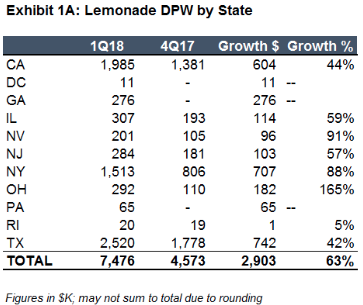
Reinsurers continue to subsidize the company’s losses: Reinsurers incurred $3.53 for every $1 in premium they received in the most recent quarter. The aggregate XOL reinsurance contract normally runs another two years (through 6/30/2020), illustrating why reinsurers that back startups also consider having equity participation.
See also: Touching Customers in the Insurtech Era
A homeowner’s company would typically aim for numbers something like the following (which are from a leading homeowner’s insurer), plus or minus a few points:

Compare with Lemonade’s numbers:
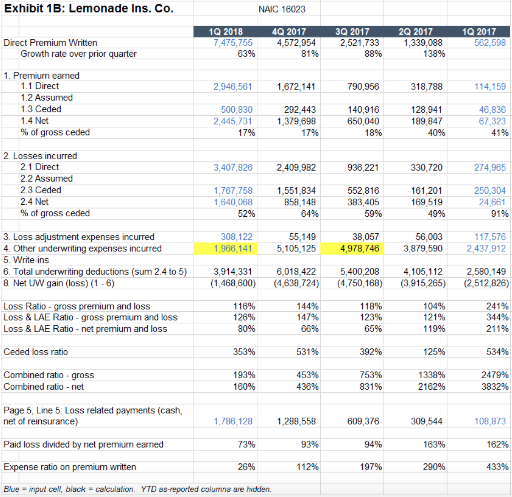 The Giveback
The Giveback
Lemonade’s
giveback is one of the company’s most intriguing features. Customers join cohorts, and, if any premium remains after paying the cohort’s claims, fees and reinsurance, that money goes to a designated charity.
Lemonade says that this “giveback” was 10% of “revenues Lemonade recognized” from its launch in 2016 until mid-2017. Another is coming in mid-2018.
Lemonade has hinted at “an exponentially larger giveback in years to come.” We’re not so sure. There are two big headwinds. First, Lemonade raised the fee paid from its cohorts to the parent company from 20% to 25%, effective 1/1/2018. Such arrangements are common in the insurance industry and are approved by regulators, but not always gladly. Sometimes profit is moved to an affiliated agency that doesn’t have to pay claims, while losses remain in the regulated insurer.
The second headwind against the giveback is that Lemonade’s cohorts have to pay for reinsurance, the cost of which is almost certain to rise in 2020 if the company continues ceding several times more losses than premiums. The giveback will probably remain – someone’s cohort will have very low losses – but the combined effects of a bigger fee to the parent and more expensive reinsurance could greatly reduce the giveback “in years to come.”
This matters because the giveback is the crux of Lemonade’s business model for both its investors and customers. As CEO Daniel Schreiber has
explained:
“If there is underwriting profit it is donated to non-profit - if it isn't and there are insufficient funds the reinsurers have a bad day, not Lemonade.
"The 20% is insulated - we take 20% in good years and in bad and that is not really impacted by loss ratios - so we are indifferent to the level of claims.”
Set aside the line about being “indifferent to the level of claims.” The 20% is not insulated – it has already gone up – and reinsurers usually seek “payback” if they have a bad day. Payback means higher reinsurance fees such that, over time, reinsurers make at least a modest profit margin. That means a bad day may be coming for Lemonade, though perhaps not until late 2020. What would happen to the company’s vaunted social mission and behavioral incentives if the economics stop adding up?
Lemonade has the cash to weather a lot of bad days and maybe even a pivot or two. The company confirmed its shareholding structure in the first quarter, and the figures support (but do not precisely confirm) the
rumored $600 million valuation when Softbank and other investors put in $120 million.
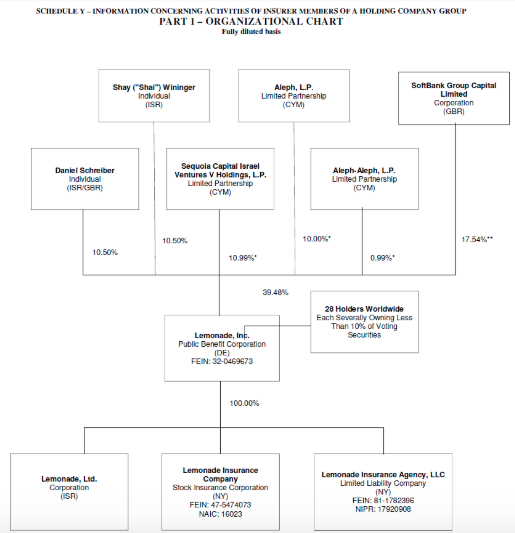
In the past weeks, Lemonade’s
Policy 2.0 initiative has generated a relevant debate and raised challenges to regulators, who will have to examine the policy and deal with claims disputes. Ambiguity in an insurance contract typically is interpreted against the insurer, which could make it that much harder to get the loss ratio down. Lemonade remains a challenging company for regulators, and traditional agents are lining up
to kill any regulatory flexibility given to insurtechs.
Lastly, we comment on a quiet but meaningful accounting change. The 20% fee paid by Lemonade Insurance Co. (now 25%) was far less than the actual cost of the services received. Lemonade Insurance Co. used to report consolidated figures that gave a true representation of the cost of running its operation. No longer. Effective in 2018, the consolidation is gone, and perhaps $3 million of expenses seem to be missing in 1Q18 – highlighted in yellow above. In terms of disclosure, throughout 2017, Lemonade used the language shown below. The highlighted language is the key bit that is missing in 2018.
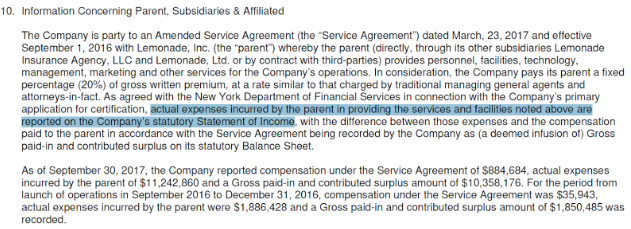
Now in 2018:
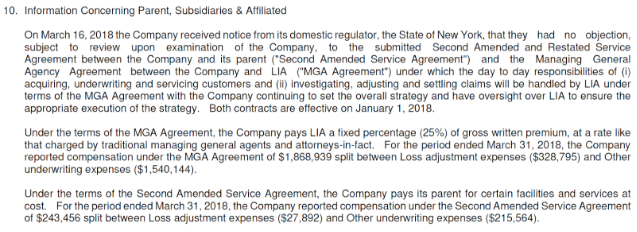
Transparency….
Root Insurance Co.
Root has grown explosively, with gross premiums written having trebled since 4Q17, for a run rate exceeding $30 million. $2.9 million of $7.9 million of gross premiums written were in Texas, with Ohio and Arizona also chipping in more than $1 million each. Potentially most impressive is that Root apparently has achieved its growth without massive advertising spending. If ad spending as a percent of total expenses remained constant this quarter compared with last year (a big “if,” because overall expense are rising rapidly), then Root has greatly cut its ad spending as a percent of the premium. See the bottom line of Exhibit 2.
As with Metromile and Lemonade, Root’s loss ratio remains unsustainably high, but the company’s $51 million fundraising round in June gives it a few years of runway to make improvements. Following our previous article, the CEO of Root
commented that his company’s loss ratio was high in part due to prudent reserving. Indeed, Root was the only of the three startup insurers to report favorable development in the quarter, to the tune of $239,000 of gross positive development, which would cut almost 10 points off the 2017 gross loss ratio. (In reality, Root cut about seven points from the 1Q18 loss ratio, because prior year results aren’t restated when reserves develop.) There could continue to be favorable development, but so far the 2017 loss ratio would be cut from 138% to 128% -- still well above a sustainable level. Further, the company in 2017 paid $1.36 of losses for every $1 of premium earned (on a net basis).
Root’s reinsurance comes up for renewal at the end of June 2018 and currently consists of a 50% quota share and $1M XS $100K tower, which limits volatility in results.
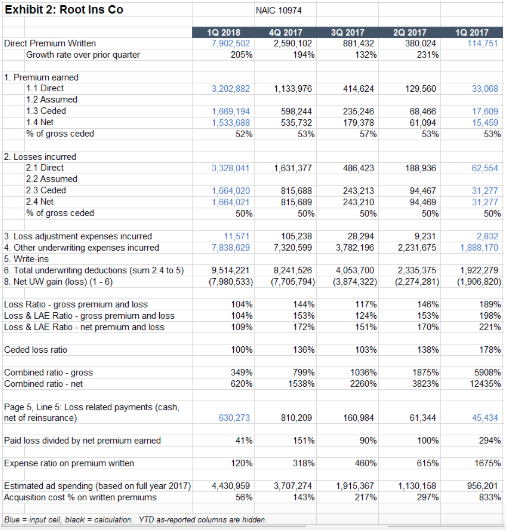 Metromile Insurance Co.
Metromile Insurance Co.
Metromile, the oldest and the biggest of the three, continues to grow premium – achieving an impressive plus-25% quarter-to-quarter, nearing an $80 million run rate. California continues to be the largest state for Metromile, accounting for $11 million of $19 million of direct premium written this quarter, as compared with $5 million of $10 million in the first quarter of 2017, which suggests that the company relies on one state but has room to expand. The company appears to be losing money in each state.
As with other insurtechs, distribution has been easier than profitability. The gross loss ratio including LAE at 104% remains close to the results posted in 2017 but above a sustainable long-term rate. For comparison, Progressive’s personal lines loss & LAE ratio was 74% in 2017 (30 points lower), with a combined ratio of 93%. The gross loss ratio is affected by $1.5 million of adverse development at Metromile, which added about eight points to the loss ratio this quarter.
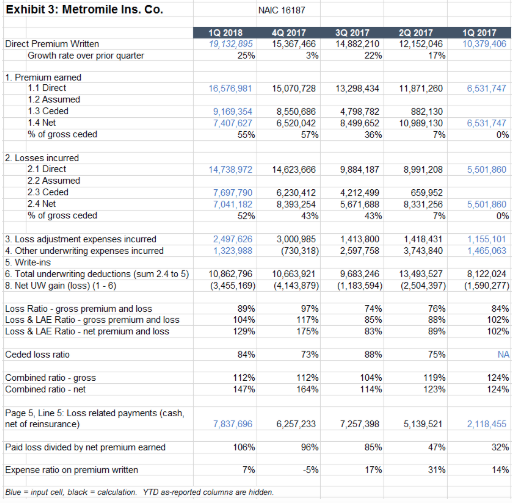 Does loss ratio scale?
Does loss ratio scale?
We have been surprised to hear some investors comment that they expect loss ratios to decline with scale and to consider them as any other costs on the insurance income statement. There are some elements of loss ratio that scale, but only in a limited way, i.e. a few points, not cutting the loss ratio in half.
- Claims: Taking claims in-house at the right time can reduce the loss & LAE ratio. TPAs get paid to manage and settle claims, which isn’t always exactly what carriers or MGAs want. (Claims is a moment of truth that drives loyalty, and insurance fraud is real.) Bigger insurers also have better ability to drive favorable pricing with repair shops, contractors and outside adjusters.
- Portfolio management: Scale can enable the company to be more selective about risks underwritten, thus avoiding the worst risks. It’s hard to manage a portfolio (i.e. cut the worst risks) when also growing it rapidly from a small base.
- Underwriting: Scale can help the company understand its own loss experience and adjust its underwriting accordingly. When companies start, they assess what risks are good or bad using industry data and place bets that certain segments are more attractive, thus targeting those segments or distributors that target them. As the company gathers data on the performance of its own book, through time and scale, the company can adjust underwriting and pricing to attract customer segments that perform particularly well for its particular business model. Again this has a trade-off against growth.
- Mathematics: The law of large numbers will cause actual loss ratios to converge closer to the expected loss ratio. This isn’t really the loss ratio scaling down, but rather limiting the probability of a single really bad loss poisoning a year’s results.
However, when an insurer says that “we are indifferent to the level of claims” and then turns in a loss ratio that is double a sustainable level, investors should ask themselves, “What if they really are indifferent?”
See also: Why Financial Wellness Is Elusive
Conclusion
We have been grateful for the positive feedback on our first article covering 2017 results, with both startups and incumbents featuring highly on the list of companies whose employees read the article. So far, 2018 results do not lead us to change
our conclusions from 2017.
The three companies we’ve analyzed have several years of cash on hand, during which time they will probably continue to grow rapidly. They will probably improve their loss ratios, and expense ratios will scale down. The question is whether the figures get to a sustainable level. We won’t know for a few years whether these daring start-ups are really ground breakers or just expensive follies – as long as they are not acquired in the meantime. We’re cheering for them and think that we will see rapid growth and also profitability improvements in future quarters.
We were asked a few times about other companies, particularly in non-U.S. markets. Many countries have similar filings to the U.S. statutory filings, but we’ve not published anything on them yet. Also, agencies and brokers typically do not file public financials. We have begun to observe a trend, such as with
Next Insurance, of insurtech agencies converting to carriers or at least exploring the idea seriously. There are many reasons why this makes sense at a certain point in a company’s development, and it will provide more insurtech carriers’ financials to analyze in years to come.
To be notified of future articles, please follow Matteo and Adrian Jones on LinkedIn or subscribe to Insurance Thought Leadership's Six Things weekly newsletter. You can also find us at the leading conferences, including:
Adrian: Plug and Play Summer Summit in Silicon Valley, InsurTech Insights in London, Rendez-Vous de Septembre in Monte Carlo and InsureTech Connect in Vegas.
Matteo: InsiderTech London, Connected Insurance Summit in London, InsurTech Insights in London, NAIC Insurance Summit in Kansas City, Rendez-Vous de Septembre in Monte Carlo, Annual North America Re/Insurance Conference in New York and InsureTech Connect in Vegas. Reinsurers continue to subsidize the company’s losses: Reinsurers incurred $3.53 for every $1 in premium they received in the most recent quarter. The aggregate XOL reinsurance contract normally runs another two years (through 6/30/2020), illustrating why reinsurers that back startups also consider having equity participation.
See also: Touching Customers in the Insurtech Era
A homeowner’s company would typically aim for numbers something like the following (which are from a leading homeowner’s insurer), plus or minus a few points:
Reinsurers continue to subsidize the company’s losses: Reinsurers incurred $3.53 for every $1 in premium they received in the most recent quarter. The aggregate XOL reinsurance contract normally runs another two years (through 6/30/2020), illustrating why reinsurers that back startups also consider having equity participation.
See also: Touching Customers in the Insurtech Era
A homeowner’s company would typically aim for numbers something like the following (which are from a leading homeowner’s insurer), plus or minus a few points:
 Compare with Lemonade’s numbers:
Compare with Lemonade’s numbers:
 The Giveback
Lemonade’s giveback is one of the company’s most intriguing features. Customers join cohorts, and, if any premium remains after paying the cohort’s claims, fees and reinsurance, that money goes to a designated charity. Lemonade says that this “giveback” was 10% of “revenues Lemonade recognized” from its launch in 2016 until mid-2017. Another is coming in mid-2018.
Lemonade has hinted at “an exponentially larger giveback in years to come.” We’re not so sure. There are two big headwinds. First, Lemonade raised the fee paid from its cohorts to the parent company from 20% to 25%, effective 1/1/2018. Such arrangements are common in the insurance industry and are approved by regulators, but not always gladly. Sometimes profit is moved to an affiliated agency that doesn’t have to pay claims, while losses remain in the regulated insurer.
The second headwind against the giveback is that Lemonade’s cohorts have to pay for reinsurance, the cost of which is almost certain to rise in 2020 if the company continues ceding several times more losses than premiums. The giveback will probably remain – someone’s cohort will have very low losses – but the combined effects of a bigger fee to the parent and more expensive reinsurance could greatly reduce the giveback “in years to come.”
This matters because the giveback is the crux of Lemonade’s business model for both its investors and customers. As CEO Daniel Schreiber has explained:
The Giveback
Lemonade’s giveback is one of the company’s most intriguing features. Customers join cohorts, and, if any premium remains after paying the cohort’s claims, fees and reinsurance, that money goes to a designated charity. Lemonade says that this “giveback” was 10% of “revenues Lemonade recognized” from its launch in 2016 until mid-2017. Another is coming in mid-2018.
Lemonade has hinted at “an exponentially larger giveback in years to come.” We’re not so sure. There are two big headwinds. First, Lemonade raised the fee paid from its cohorts to the parent company from 20% to 25%, effective 1/1/2018. Such arrangements are common in the insurance industry and are approved by regulators, but not always gladly. Sometimes profit is moved to an affiliated agency that doesn’t have to pay claims, while losses remain in the regulated insurer.
The second headwind against the giveback is that Lemonade’s cohorts have to pay for reinsurance, the cost of which is almost certain to rise in 2020 if the company continues ceding several times more losses than premiums. The giveback will probably remain – someone’s cohort will have very low losses – but the combined effects of a bigger fee to the parent and more expensive reinsurance could greatly reduce the giveback “in years to come.”
This matters because the giveback is the crux of Lemonade’s business model for both its investors and customers. As CEO Daniel Schreiber has explained:
 In the past weeks, Lemonade’s Policy 2.0 initiative has generated a relevant debate and raised challenges to regulators, who will have to examine the policy and deal with claims disputes. Ambiguity in an insurance contract typically is interpreted against the insurer, which could make it that much harder to get the loss ratio down. Lemonade remains a challenging company for regulators, and traditional agents are lining up to kill any regulatory flexibility given to insurtechs.
Lastly, we comment on a quiet but meaningful accounting change. The 20% fee paid by Lemonade Insurance Co. (now 25%) was far less than the actual cost of the services received. Lemonade Insurance Co. used to report consolidated figures that gave a true representation of the cost of running its operation. No longer. Effective in 2018, the consolidation is gone, and perhaps $3 million of expenses seem to be missing in 1Q18 – highlighted in yellow above. In terms of disclosure, throughout 2017, Lemonade used the language shown below. The highlighted language is the key bit that is missing in 2018.
In the past weeks, Lemonade’s Policy 2.0 initiative has generated a relevant debate and raised challenges to regulators, who will have to examine the policy and deal with claims disputes. Ambiguity in an insurance contract typically is interpreted against the insurer, which could make it that much harder to get the loss ratio down. Lemonade remains a challenging company for regulators, and traditional agents are lining up to kill any regulatory flexibility given to insurtechs.
Lastly, we comment on a quiet but meaningful accounting change. The 20% fee paid by Lemonade Insurance Co. (now 25%) was far less than the actual cost of the services received. Lemonade Insurance Co. used to report consolidated figures that gave a true representation of the cost of running its operation. No longer. Effective in 2018, the consolidation is gone, and perhaps $3 million of expenses seem to be missing in 1Q18 – highlighted in yellow above. In terms of disclosure, throughout 2017, Lemonade used the language shown below. The highlighted language is the key bit that is missing in 2018.
 Now in 2018:
Now in 2018:
 Transparency….
Root Insurance Co.
Root has grown explosively, with gross premiums written having trebled since 4Q17, for a run rate exceeding $30 million. $2.9 million of $7.9 million of gross premiums written were in Texas, with Ohio and Arizona also chipping in more than $1 million each. Potentially most impressive is that Root apparently has achieved its growth without massive advertising spending. If ad spending as a percent of total expenses remained constant this quarter compared with last year (a big “if,” because overall expense are rising rapidly), then Root has greatly cut its ad spending as a percent of the premium. See the bottom line of Exhibit 2.
As with Metromile and Lemonade, Root’s loss ratio remains unsustainably high, but the company’s $51 million fundraising round in June gives it a few years of runway to make improvements. Following our previous article, the CEO of Root commented that his company’s loss ratio was high in part due to prudent reserving. Indeed, Root was the only of the three startup insurers to report favorable development in the quarter, to the tune of $239,000 of gross positive development, which would cut almost 10 points off the 2017 gross loss ratio. (In reality, Root cut about seven points from the 1Q18 loss ratio, because prior year results aren’t restated when reserves develop.) There could continue to be favorable development, but so far the 2017 loss ratio would be cut from 138% to 128% -- still well above a sustainable level. Further, the company in 2017 paid $1.36 of losses for every $1 of premium earned (on a net basis).
Root’s reinsurance comes up for renewal at the end of June 2018 and currently consists of a 50% quota share and $1M XS $100K tower, which limits volatility in results.
Transparency….
Root Insurance Co.
Root has grown explosively, with gross premiums written having trebled since 4Q17, for a run rate exceeding $30 million. $2.9 million of $7.9 million of gross premiums written were in Texas, with Ohio and Arizona also chipping in more than $1 million each. Potentially most impressive is that Root apparently has achieved its growth without massive advertising spending. If ad spending as a percent of total expenses remained constant this quarter compared with last year (a big “if,” because overall expense are rising rapidly), then Root has greatly cut its ad spending as a percent of the premium. See the bottom line of Exhibit 2.
As with Metromile and Lemonade, Root’s loss ratio remains unsustainably high, but the company’s $51 million fundraising round in June gives it a few years of runway to make improvements. Following our previous article, the CEO of Root commented that his company’s loss ratio was high in part due to prudent reserving. Indeed, Root was the only of the three startup insurers to report favorable development in the quarter, to the tune of $239,000 of gross positive development, which would cut almost 10 points off the 2017 gross loss ratio. (In reality, Root cut about seven points from the 1Q18 loss ratio, because prior year results aren’t restated when reserves develop.) There could continue to be favorable development, but so far the 2017 loss ratio would be cut from 138% to 128% -- still well above a sustainable level. Further, the company in 2017 paid $1.36 of losses for every $1 of premium earned (on a net basis).
Root’s reinsurance comes up for renewal at the end of June 2018 and currently consists of a 50% quota share and $1M XS $100K tower, which limits volatility in results.
 Metromile Insurance Co.
Metromile, the oldest and the biggest of the three, continues to grow premium – achieving an impressive plus-25% quarter-to-quarter, nearing an $80 million run rate. California continues to be the largest state for Metromile, accounting for $11 million of $19 million of direct premium written this quarter, as compared with $5 million of $10 million in the first quarter of 2017, which suggests that the company relies on one state but has room to expand. The company appears to be losing money in each state.
As with other insurtechs, distribution has been easier than profitability. The gross loss ratio including LAE at 104% remains close to the results posted in 2017 but above a sustainable long-term rate. For comparison, Progressive’s personal lines loss & LAE ratio was 74% in 2017 (30 points lower), with a combined ratio of 93%. The gross loss ratio is affected by $1.5 million of adverse development at Metromile, which added about eight points to the loss ratio this quarter.
Metromile Insurance Co.
Metromile, the oldest and the biggest of the three, continues to grow premium – achieving an impressive plus-25% quarter-to-quarter, nearing an $80 million run rate. California continues to be the largest state for Metromile, accounting for $11 million of $19 million of direct premium written this quarter, as compared with $5 million of $10 million in the first quarter of 2017, which suggests that the company relies on one state but has room to expand. The company appears to be losing money in each state.
As with other insurtechs, distribution has been easier than profitability. The gross loss ratio including LAE at 104% remains close to the results posted in 2017 but above a sustainable long-term rate. For comparison, Progressive’s personal lines loss & LAE ratio was 74% in 2017 (30 points lower), with a combined ratio of 93%. The gross loss ratio is affected by $1.5 million of adverse development at Metromile, which added about eight points to the loss ratio this quarter.
 Does loss ratio scale?
We have been surprised to hear some investors comment that they expect loss ratios to decline with scale and to consider them as any other costs on the insurance income statement. There are some elements of loss ratio that scale, but only in a limited way, i.e. a few points, not cutting the loss ratio in half.
Does loss ratio scale?
We have been surprised to hear some investors comment that they expect loss ratios to decline with scale and to consider them as any other costs on the insurance income statement. There are some elements of loss ratio that scale, but only in a limited way, i.e. a few points, not cutting the loss ratio in half.





